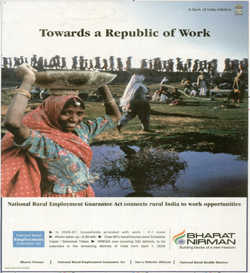Drowning in a paper sea: India’s welfare efforts failed by its peculiar bureaucracy
India’s sophisticated laws and progressive policies fail with startling regularity. A new study locates a possible reason as to why in the convoluted bureaucratic system of the Indian state and its obsession with paper.
 One of the world’s largest anti-poverty measures – a scheme designed to guarantee 100 days’ work to poor, rural households in India – has become bogged down in a bureaucratic quagmire, according to recently-published research.
One of the world’s largest anti-poverty measures – a scheme designed to guarantee 100 days’ work to poor, rural households in India – has become bogged down in a bureaucratic quagmire, according to recently-published research.
The Mahatma Gandhi National Rural Employment Guarantee Act, 2005 (MNREGA) is the subject of Paper Tiger by Cambridge anthropologist Nayanika Mathur. The Act covers all of India’s rural population (or about 70% of India’s 1.3 billion people) and is supposed to guarantee work for unskilled labourers at the minimum wage.
Launched amid huge fanfare in February 2006, MNREGA’s performance continues to be the object of strenuous debate in India. “MNREGA was put forward as a radical, progressive move, enshrining the right to work,” said Mathur. “This was a sophisticated legislation that potentially has a lot of promise. But I wanted to see first hand how a law authored by elites in New Delhi, in English, gets put into practice in one of the poorest parts of India.”
Mathur chose to study this welfarist statute through an innovative anthropological method: embedding herself within the development bureaucracy of the state in a remote and impoverished Himalayan district.
She spent a total of 18 months following the implementation of MNREGA through different levels of the Indian state. Almost a year was spent living in the town of Gopeshwar in Chamoli district, in the remote central Himalayan state of Uttarakhand. With its high levels of poverty, unemployment and distress out-migration, Mathur chose to base her research in the Himalaya to see how MNREGA was – or wasn’t – being put into practice at a local level.
To read the full article see University of Cambridge Research News.
